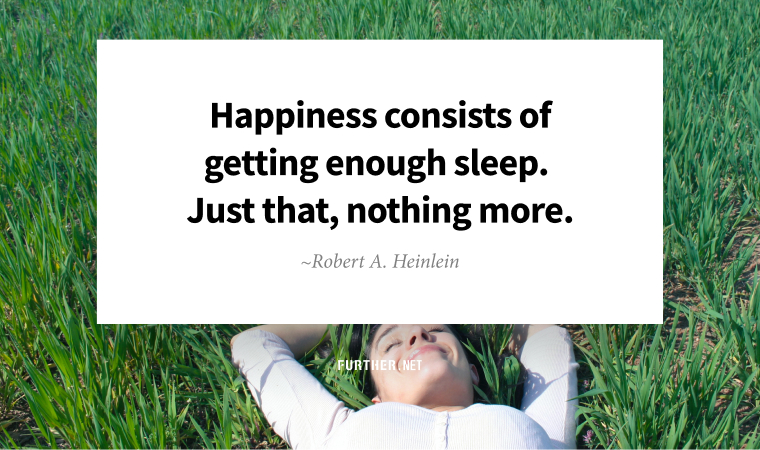
Well + Wealthy is now open and off to great start! Join us here, or watch the replay of Krista Stryker’s fitness presentation first.
When we’re young, we set off to conquer the world.
That involves education and employment. Then career, cars, houses, children. There’s always the next achievement and the next milestone to pursue.
No matter how hard we ran, there was never a finish line. As each milestone was achieved, we felt satisfaction, perhaps even a bit happiness. But it didn’t last, so off we ran toward the next marker.
Throughout our run on this hedonic treadmill, we had ways to determine if we were “conquering” — we compared ourselves to others, and fretted about what others thought of us. As counterproductive as both can be, they are baked into us at the genetic level:
According to evolutionary psychology, our tendency to strive for more is perfectly understandable. Throughout most of human history, starvation loomed closer than it does, for the most part, today. Competing with rivals for mates helps explain our weird fixation on social comparison.
The world has changed drastically since then, but our brains haven’t. Our vestigial urges — the software that still exists in our brains from ancient times — cause our acquisitive tendencies to persist well beyond our needs:
It makes no sense in modern life to use our energies to have five cars, five bathrooms, or even five pairs of sneakers, but we just … want them. Neuroscientists have looked into this. Dopamine is excreted in response to thoughts about buying new things, winning money, acquiring more power or fame, having new sexual partners.
What’s interesting is this starts to unravel a bit for many people in their 40s. You may start to realize that comparing yourself to others is the root of your unhappiness. And you may also start to question the path you’ve been on, especially if social rewards and peer approval have fueled the choices you’ve made.
For those who experience these midlife doldrums, we usually make our way through and get happier around 50. This is the U-shaped happiness curve, but why does it happen? Have we simply lived long enough to gain wisdom, or are the same forces of evolutionary psychology ready to put us out to pasture based on historically shorter lifespans?
Regardless of the mechanism, the point is we’re not done yet. And with additional extensions in both lifespan and healthspan on the horizon, it’s vitally important that we shed outmoded forms of motivation and find meaningful forms of work to survive and thrive.
“Less” doesn’t necessarily mean doing or being less. It means pursuing projects that have nothing to do with acquiring more “stuff” or gaining approval from others, especially given that neither has managed to bring lasting satisfaction so far (hint, that won’t change).
That can be tough, because we still have to fight the urges of our inner caveman. But once you realize that you are more than your genetic programming, you can obtain the only thing you’re here to achieve — mastery of your self.
How to Want Less, an excerpt from the new book From Strength to Strength: Finding Success, Happiness, and Deep Purpose in the Second Half of Life (Amazon)
Keep going-
P.S. New to Further? Join us here.
The Weighting is the Hardest Part
“I’m doing everything right, exercising and eating well. So why am I not losing weight?” First, we need to challenge the assumption that weight loss is simple or easy.
Resigned to Greatness
If you are one of the many people considering a midlife career change during this wave of the Great Resignation, it’s critical to plan and prepare for how this change might affect you and your finances.
7 Financial Planning Strategies for Your Own ‘Great Resignation’
The Crypto Bowl
Crypto was all over the commercials during the Super Bowl, and Bitcoin and Ethereum seem to be recovering after a winter dip. Is now the time to dive in?
Crypto Is Recovering. Is It Time to Invest?
Relationship Rave
For some couples on the brink of divorce, taking MDMA together in a therapeutic setting was a last resort — but it ended up being the only thing that worked.
The Japanese Secret to Getting a Good Night’s Sleep
By Trudi Roth
Remember when “sleeping in” meant you got up at noon, not 7:00 am? That’s a sure sign of midlife, where things we once took for granted health-wise become challenging. Research shows a third of adults sleep less than seven hours a night, and up to 30% deal with chronic insomnia.
Sleep is not only a vital aspect of lifespan and healthspan; it’s also a critical factor in daily functioning. Sleep deprivation makes you less productive, focused, and innovative, and more stressed, moody, and susceptible to getting sick.
So, it’s understandable if your mantra is, “I won’t rest until I get a good night’s sleep.” However, that can become one more anxiety that keeps you up at night. Instead, pour yourself a cup of Hojicha tea, relax, and try the Japanese kaizen method to make small, consistent adjustments for better sleep.
A Little Rest
You might have heard about the Japanese productivity philosophy, kaizen (“good change”), as it applies to manufacturing. Popularized by Toyota after World War II, the idea is to minimize waste and maximize efficiencies by implementing continuous incremental changes. Today we see the approach applied not only to people’s work lives but also to their private lives, helping make personal improvement easier and more accessible.
It might seem daunting to try to change your whole sleep routine in one go, but making one small step at a time will encourage you to adopt better bedtime habits — and hopefully, once one change starts to make a difference, then you will be motivated to make more.
All you have to do to use kaizen to optimize your Zs is take it easy.
Simplify Your Slumber
There are reasons you toss and turn, and that’s the jumping-off point for using kaizen to sleep better. Begin the process by keeping a sleep journal for a week, where you record when you fall asleep, wake up, experience sleep interruptions, and the total time you sleep nightly.
After a week, look for patterns and possible sleep-robbing factors, like having stimulants before bedtime (i.e., alcohol, caffeine), a noisy/messy/too bright room, or using screens before you turn in. Then, little by little, make adjustments, such as:
- Tidy up the space around your bed for five minutes (vs. cleaning the whole room)
- Try wearing an eye mask
- Stick to a “communication blackout” (no screens two hours before bed)
- Meditate for five minutes before bed
Focus on one small thing a night, and notice if it makes a difference. For example, if the eye mask helps, you might invest in blackout shades. Keep in mind not every tweak will help, and sometimes your body won’t comply. The point is to give your inner critic a rest as you patiently figure out the best sleep routine for you.
How to Sleep: Try Japan’s Kaizen Method to Cure Insomnia and Sleep Anxiety (Stylist)
further: flashback
 Billy Idol – Rebel Yell
Billy Idol – Rebel YellRebel Yell, 1983
further: sharing

Further subscribers earn $MOVE coin by sharing Further with friends to gain access to our exclusive membership community Well + Wealthy. Get your own free weekly dose of health, wealth, travel, and happiness advice here, and get all the details on our referral program.
Thank you for sharing Further!

